
by Osprey Photo Workshops & Tours | Aug 8, 2021 | Autumn photography, Chincoteague NWR, Nature, Nature Photography, Photo Tours, Photo Workshops, Wildlife, Wildlife Photography
Trip Report, Chincoteague NWR, November 2020
Nature Photography
Chincoteague NWR is located on the southern Virginia end of the barrier island of Assateague. In the fall, the refuge attracts large numbers of snow geese along with ducks, swans, herons, ospreys, shorebirds and other migrants. It is also the home to wild horses, deer, raccoon, fox squirrels, and other animals. Used to being protected, the wildlife is unusually tolerant of humans and presents visitors with great photo opportunities. It is one of my favorite places to photograph wildlife in both the fall and spring. I have been conducting photo workshops there for many years. Numbers of species and the variety has shifted over the years. The refuge is located along the Atlantic Flyway. Once over 40,000 snow geese stopped at the refuge doing fall migration Now they stop farther north but still several thousands visit the refuge today along with shorebirds, swans, and other waterfowl.


Chincoteague NWR website:
https://www.fws.gov/refuge/chincoteague/
Trip report – Fall 2020
First Stop – Sunrise
For sunrise I typically stop along Beach Road at the first large pool on the right after passing the visitors center– Black Duck Pool. There are convenient pull offs for cars on both sides of the road. At sunrise, I often see deer crossing the water.
I had a treat one morning at sunrise when a large flock of White Ibis circled overhead with many landing in front of me. They were joined by herons and a few ducks. When photographing the birds against colored sky and water, I had to be careful that their silhouettes did not merge with the silhouettes of other birds or the surrounding grasses.
Several mornings were foggy and allowed me to create images different from many I have taken here before at this location. The two photos below were taken on one of those mornings. I like the layers revealed by the lifting fog and sense of calm these images invoke. In terms of exposure if using aperture priority, I had to increase my exposure compensation by at least +2. Remember that the light meter assumes it is pointed at something mid-tone and will darken the exposure to make it so, thereby underexposing the image.


First Stop – Sunrise
For sunrise I typically stop along Beach Road at the first large pool on the right after passing the visitors center– Black Duck Pool. There are convenient pull offs for cars on both sides of the road. At sunrise, I often see deer crossing the water.
I had a treat one morning at sunrise when a large flock of White Ibis circled overhead with many landing in front of me. They were joined by herons and a few ducks. When photographing the birds against colored sky and water, I had to be careful that their silhouettes did not merge with the silhouettes of other birds or the surrounding grasses.
Several mornings were foggy and allowed me to create images different from many I have taken here before at this location. The two photos below were taken on one of those mornings. I like the layers revealed by the lifting fog and sense of calm these images invoke.

In terms of exposure if using aperture priority, I had to increase my exposure compensation by at least +2. Remember that the light meter assumes it is pointed at something mid-tone and will darken the exposure to make it so, thereby underexposing the image.

Black Duck Pool
After shooting sunrise, I will check out the scene across the road for horses and herons in the early morning light. If there is nothing of interest, I typically drive towards the beach checking out the borrow ditches on the side of the road for herons, ducks and other visitor that are in good light and in a suitable non-distractive background.
Note: In the summer it is difficult to photograph wildlife other than in the early morning and late in the pm since there is a lot of traffic on Beach Road as folks head to the public beach for the day.
On the morning that I saw the flock of ibis at sunrise, I found a large number of individuals engaging in a feeding frenzy at the junction between the borrow ditch on the left and Swan Cove. They were joined by a few herons. This is the first time that I have witnessed such a high number of ibis together. When they finished feeding in one area, they moved up the borrow ditch congregating at various points along the way. My car worked beautifully as a mobile blind. I could move the car and follow the birds as they traveled upstream. I shot from the car as to not disturb the birds and used a bean bag on the window sill to securely support my lens and camera.

Occasionally in the same area I have encountered a fox or raccoon, so I am always checking the edges of the road for cooperative subjects.

Swan Cove
One of my favorite spots to photograph is Swan Cove. It typically attracts are large number of birds including shorebirds that often feed in the shallows near the road at low tide. On this trip I encountered a group of Yellowlegs and Dowitchers feeding close to the shore. Again I used my car as a mobile blind, shooting from the window with my 600 mm lens mounted on my home-made beanbag. On a day there was little wind and I was able to capture images of the birds with their reflection in the water. I always look for small ducks and grebes in this pool. On this trip I was able to photograph several tolerant Pied-Billed Grebes, Buffleheads and Ruddy Ducks close to shore, sleeping, preening and diving for food.


Black Duck Pond
Often later in the morning I check out the marsh and fields across from Black Duck Pond. I typically look for horses in the marsh and around small stands of trees. Around 9 a.m. on more than one morning, I got a number of photos as the horses crossed the marsh and fed on the grasses. Sometimes blackbirds would land on their backs, I am guessing, eating insects.

In this same area I found a cooperative female Belted Kingfisher sitting on a post. I spent a delightful hour with her as she flewdown to catch fish, landed on the post again, shook off water, preened. and stretched its wings. I got a number of great images shooting from my car with my 600 mm F4 lens combined with a 1.4 teleconverter



Also in the same marsh where there were pools of water and a channel, I was able to photograph herons feeding, groups of Buffleheads swimming the channel as well as Double-crested Cormorants swimming, diving or sitting on dead snags drying their wings. This past year the water level in the marsh was perfect for shooting across marsh at sunset.

Little Toms Cove
I frequently check out this area near the water control devices that allow water to pass under the road to Swan Cove. Often when you have an obstruction in waterway, macroinvertebrates and other organisms accumulate around the opening often attracting fish and birds. This year I encountered a bird that I had not photographed before, a Surf Scoter, a sea duck typically seen flying over the ocean. This past November there was a Horned Grebe hanging out in the same location. When the tide is out, I often see rails or oystercatchers feeding on the exposed mud flats.


Sea Ducks
In the winter some photographers go to Barnegat Light and State Park in New Jersey, The photographers brave the cold to photograph sea ducks from the jetty at the inlet — a favorite is the Harlequin Duck. I have not visited the site in the winter but have seen great results. However, conditions can be dangerous with icy rocks and a rough surf with waves that might swamp you and your equipment.
 Atlantic Shore
Atlantic Shore
I always check out the beach for a colorful sunrise or shorebirds feeding along the water’s edge. The best time to photography is when the tide is low and when more of the beach is exposed. When photographing shorebirds, in the morning at Chincoteague it is difficult to avoid shadows covering much of the bird without moving out into the surf. However with post processing in Lightroom and Camera Raw, you can lighten the shadows with a selection brush. I always concentrate on birds that are moving towards me, not retreating. In the afternoon, it is easier to capture these images since the bird often is lit by the soft warm light at the end of the day.


 x
x
Bayside
On the bayside of Little Toms Cove opposite the beach, I often find an assortment of shorebirds, herons and an occasional fox. On this visit, there were Great Egrets flying back and forth feeding near posts marking private clam beds. I also photographed aa Black-bellied Plover and a Dunlin in winter plumage feeding amongst the oddly colored organism called Sea Pork. It is a colony of tunicate organisms which are plankton feeders. Though an oral siphon, they draw seawater through their bodies and pass it through a sieve-like structure that traps food particles and oxygen, eventually to exit through the atrial siphon. One sunset when the tide was out, I captured the remarkable colors and patterns as the setting sun lite the mud flats.



Wildlife Loop
On fall afternoons, I often checked out the wildlife drive around Snow Goose Pool (only open to cars after 3 pm). This time not long after I entered the drive, I saw a flock of ducks explode in flight from the marsh. It took me a minute to realize that a bald eagle had swooped over the group. It missed catching a duck and flew back to the pine tree where it often perched near its nest. Unfortunately, I was distracted by the ducks, I missed the shot of the eagle. On other trips I have seen a pair of eagles siting on the edge of the marsh in the same area. Northern Harrier (Marsh Hawks) also hunt in the area.


Shoveler Pool
Farther around the Wildlife Loop is Shoveler Pool which typically attracts ducks, geese, and swans. I was not disappointed this year for small groups of Pintail Duck, Green-wing Teal and Black Ducks took off and landed in the pool. Each day there were a number of Tundra Swans resting and feeding in the same area. Some individuals were quite aggressive, chasing geese and other swans. Before attacking, they often became very vocal, extending their necks low to the water and picking up speed. This fall the water level was low with weeds poking through the water’s surface, often leaving me with a somewhat distracting background behind the birds.
In the background of this pool was a stand of dead pines. These are Loblolly Pines which were killed by an infestation of Southern Bark Beetles that attack old or diseased trees. In several places in the refuge you will see similar stands of dead trunks. Refuge personnel replaces these dead pine trees with hardwoods such as red maple, water oak, and sassafras, creating a more varied habitat for wildlife. During your visit you may see young trees wrapped in plastic for protection.
If all goes well in May, I will return to Chincoteague NWR to photograph, hopefully to capture new and different images.




by Osprey Photo Workshops & Tours | Oct 7, 2020 | MD, Nature Photography, Photo instruction, Photo Technique, Photo Workshops, Wildlife, Wildlife Photography
My COVID 19 Quarantine Survival Story
With the emergence of the COVID 19 virus and the “Stay at Home Order”, like many people, I temporarily panicked. How long would the virus be an issue, two weeks, a month? I could deal that. But a year or more, I had no concept how I would emotionally and financially survive. Almost all my in-person speaking in engagements and photo workshops scheduled for the spring and summer had to be cancelled. Even my fall programs are in question.

Cardinal in spring
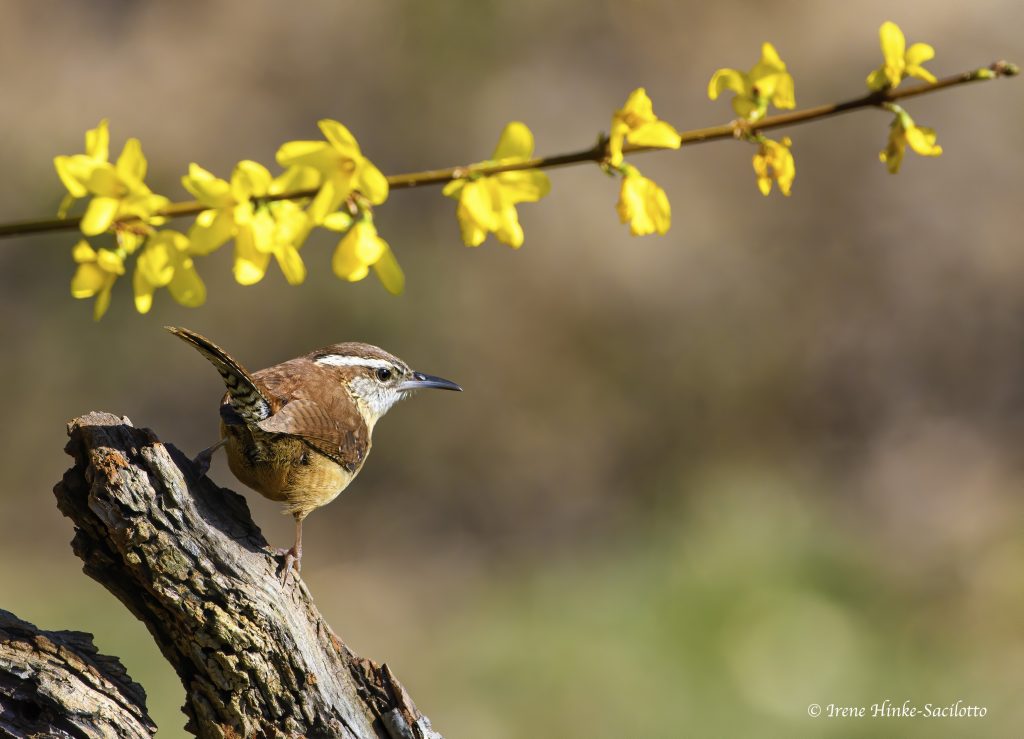
Carolina Wren photographed in local park attracted by feeder.
But I could not change conditions and was not financially destitute like many people, so I started to look for ways to turn this situation into a positive opportunity. I had plenty work to do on the computer—organizing and editing images, updating presentations, prepare advertising, producing a newsletter, etc. But I needed to be outside photographing at least part of the time. With no backyard where I could photograph, I decided to look for photo opportunities in my neighborhood. I checked out a number of trails and parks searching for non-crowded places with urban wildlife. Although some areas had limited possibilities, I did discover two gems.

Red-bellied Woodpecker landing on tree trunk.

Male Red-Bellied Woodpecker spotted when I heard it.
Initial Project:
At one park there was an osprey nest where I spent some time and I got the image above. Another park, five minutes from home, offered a number of opportunities to photograph squirrels, groundhogs, ospreys and an assortment of other birds. I created a feeder station in an open field near a line of shrubs. I baited the scene with birdseed, peanuts, suet and peanut butter. I added small evergreen branches and blooms from nearby trees for a natural looking environment. Squirrels and a variety of birds such as cardinals, wrens, sparrows, and grackles visited the site. Unfortunately, my setup disappeared when park maintenance workers unexpectedly cut the grass in the field. In addition, when the “Stay at Home Order” was issued, the park became a popular place to exercise. Many visitors came with huge bags of peanuts and bird seed which they liberally spread along the trails, attracting the resident squirrels for entertainment. With food everywhere, nothing came to my feeders. So, I had to find another location for photography.

Osprey with fish often head before seen.
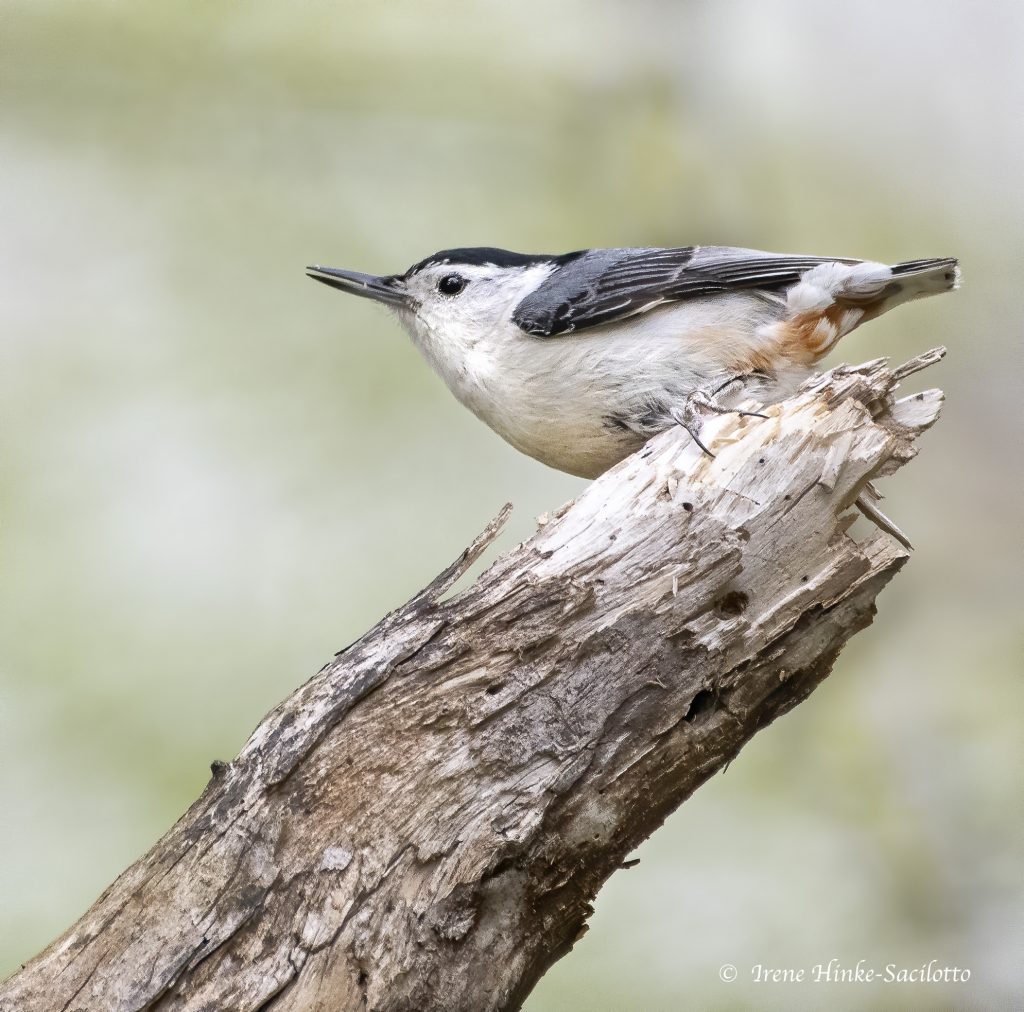
Nuthatch on branch in park.
2nd Project
Elsewhere in the park, I located a large old tree stump. It was adjacent to a path and as people passed by, they tossed peanuts and seeds on it attracting squirrels and also a variety of birds –chickadees, titmice, wrens, doves, blue jays, nuthatches, and red-bellied woodpeckers. To the scene, I added perches for the birds and some extra bird seed. I set up my tripod and camera just off of the path and was able to photograph a number of bird species. But more people kept coming to the park, making photography here more difficult.

Young Gray Squirrels in tree cavity.
3rd Project
While I was taking my daily walk for exercise, I discovered a tree cavity that was home to a family of young gray squirrels. I placed my tripod just off the path and for several days photograph the activity at the hole until the young squirrels outgrew their living quarters and left.

Young Gray Squirrel in tree cavity stretching.
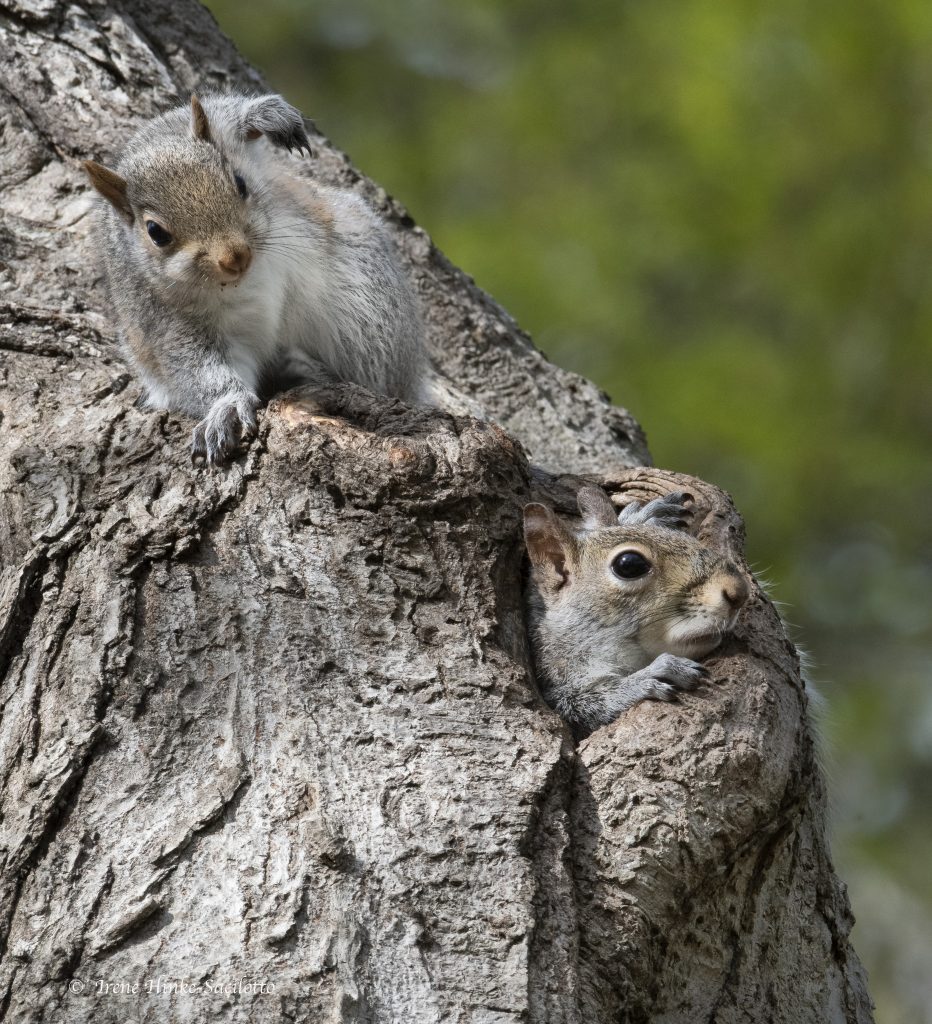
Young Gray Squirrels in cavity.
4th & Continuing Project
During the spring, I had reconnected with old friends. One living nearby owed several acres of land with an open field, a vegetable and flower garden, and woods. She is an animal lover and already had bird feeders at two locations in her yard. Better yet, on occasions, she saw foxes, groundhogs, and racoons from her porch. She was kind enough to allow me to photograph at her home and set up a blind. She loved seeing the resulting images. The experiences photographing at her house during June and July, and August will be covered in my next newsletter.

Pair of Black-capped Chickadees

by Osprey Photo Workshops & Tours | Oct 7, 2020 | Bird behavior, Bird photography, MD, Nature, Nature Photography, Photo instruction, Photo Technique, Photo Workshops, Uncategorized, Wildlife, Wildlife Photography
Urban Wildlife Photo Project
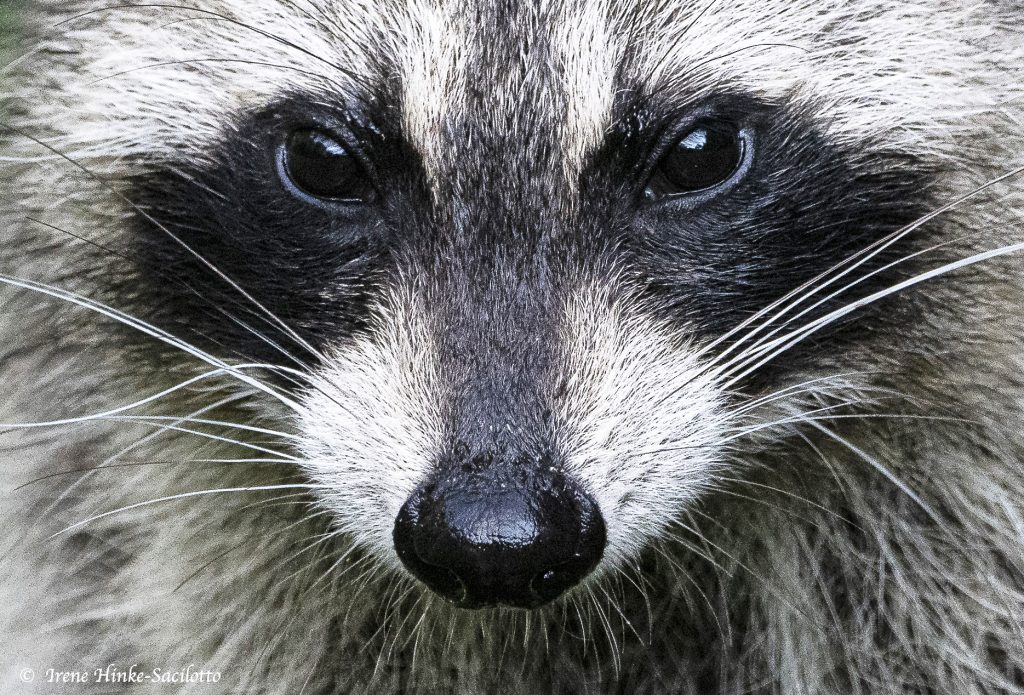
Raccoon Eyes
Overview
As mentioned in my last newsletter, in recent months I have reconnected with an old friend who has been allowing me to photograph on her property. She lives nearby and owns several acres of land with an open area, vegetable garden, flower beds, woods, and a pond by the house with aquatic plants, dragon flies and frogs. She has two permanent bird feeder locations that are near bushes and tall trees. One is located at the far end of the yard with the other near her house. Bushes and tall trees were nearby both. They provide cover from which the animals could safely approach the feeders as well as escape if threatened by hawks, foxes, or other predators. When the weather allowed from late April until today, I would spend several hours early in the morning or late in the afternoon photographing in her yard. In July when, temperatures soared into the mid to high 90s and humidity rose feeder activity slowed and was limited to the cooler times of the day and after sunset. The drop in activity seemed to continue into September.
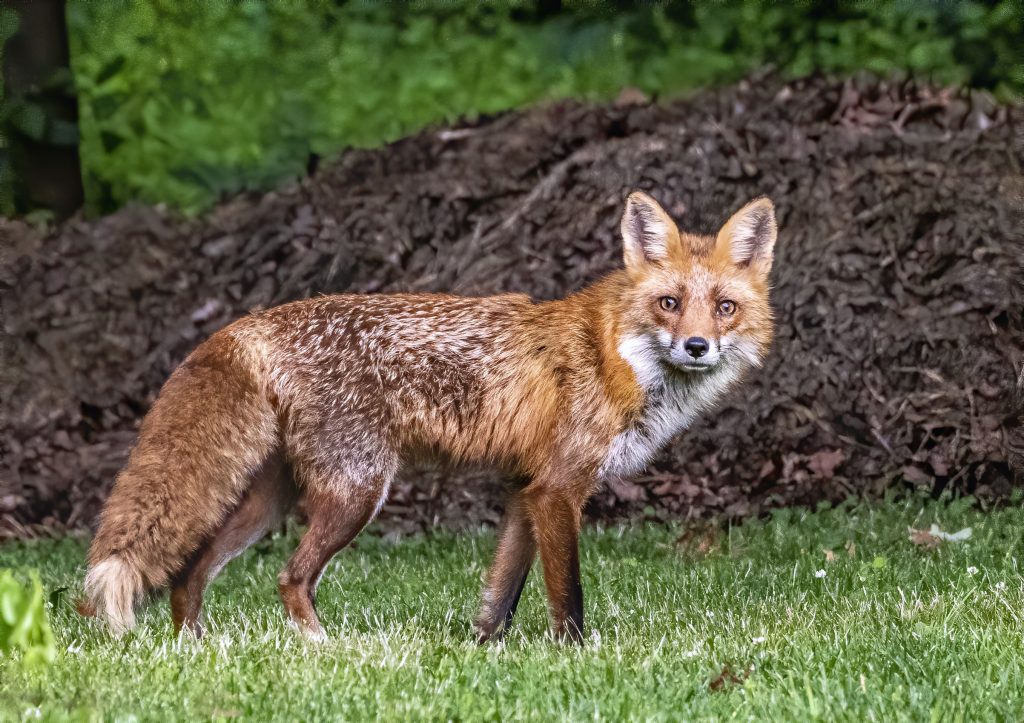
Red Fox emerging from woods.
Initial setup
In late April, I began photographing at the bird feeder nearest the house. It was close enough that I could photograph from my friend’s dining room window. In addition to standard bird seed and suet feeders, we hung a thistle sock on a branch to attract gold and purple finches. The non-melt suet, that could withstand the summer heat, attracted the small woodpeckers, chickadees, and nuthatches. At times we added meal worms to the mix, which seemed to be a favorite of the Carolina Wrens. The bird feeder at this location was elaborate with arms and multiple hooks from which to hang a variety of feeders. I added a few natural perches for the birds to land on, but to my disappointment, they seemed to prefer sitting on the iron appendages of the feeder stand. After several days shooting, I concluded that the way the sunlight hit the area was not ideal for it cast unwanted shadows on the birds. In addition, the bushes behind the feeders were very close making it difficult to blur the background even with the lens wide open and a shallow depth of field. It became even more distracting when hit by bright sunlight.

Raccoon eating apple put out to attract deer.
Second location
Adaptability, perseverance, and patience are all keys to successfully photographing animal behavior. When I failed to get satisfactory results at my first location, I shifted my attention to activity around the permanent feeder at the far end of the yard. Nearby, there was a bird bath and kiddy pool filled with water to attract wildlife on hot dry days. Since I did not want to photograph the birds at the feeder, I created what I have affectionately call my animal jungle jim. With logs, tree roots, branches, other items that I collected roadside and from nearby woods, I created a setup where I hung additional feeders and provided a safe place for the birds to perch. At key locations on the logs, I smeared peanut butter and suet. For the squirrels, raccoons, and jays, I added unsalted, raw peanuts to the wildlife buffet. After watching squirrels for an extended period of time, I am convinced that they are smart and agile and that very few bird feeders are squirrel-proof.

Black-capped Chickadee with the sun breaking through trees behind it.

Post to attract woodpeckers and the birds with suet block nearby.
Urban Wildlife Photo Project (cont.)
Periodically, I changed the arrangement to vary the background in my photos. For variety, I added a vertical 4-foot-long tree trunk cemented in a bucket that I could move to different locations. I baited it with a peanut butter/suet mix and placed a cage filled with suet nearby hoping woodpeckers and other birds would first perch on the trunk before jumping to the feeder. I added a small tree to the mix for birds to perch in, hoping to vary the appearance of my images.
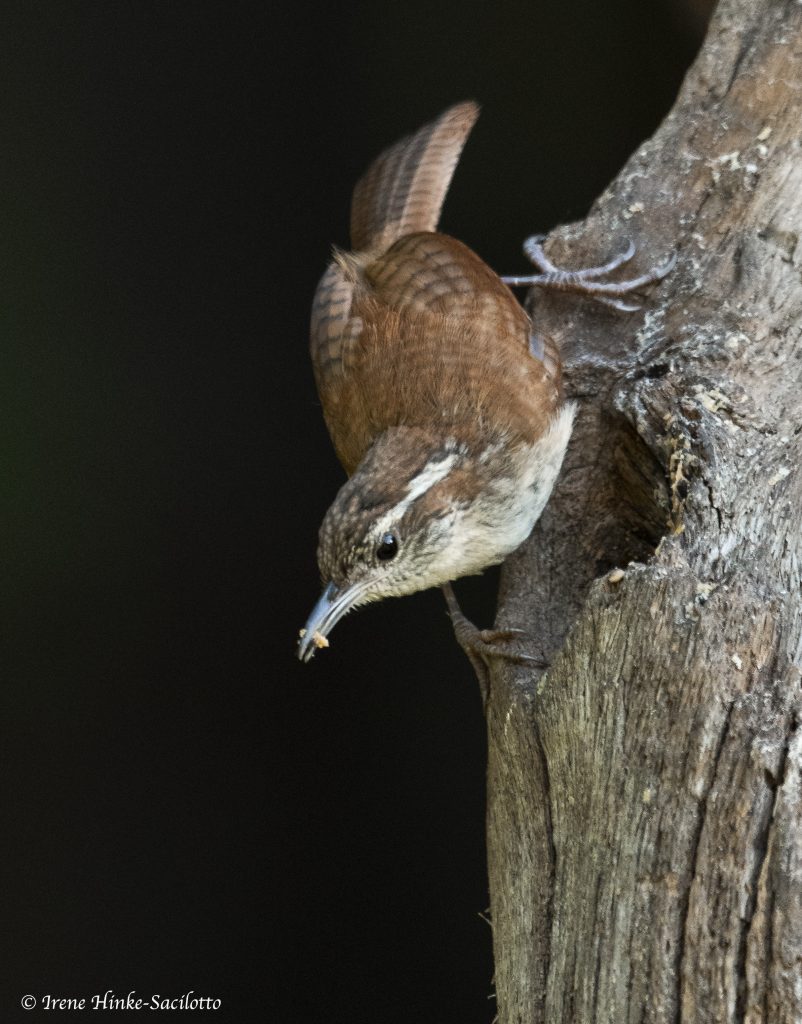
Carolina wren on post.

Downey woodpecker on side of tree trunk.

Frog escaping from backyard pond.
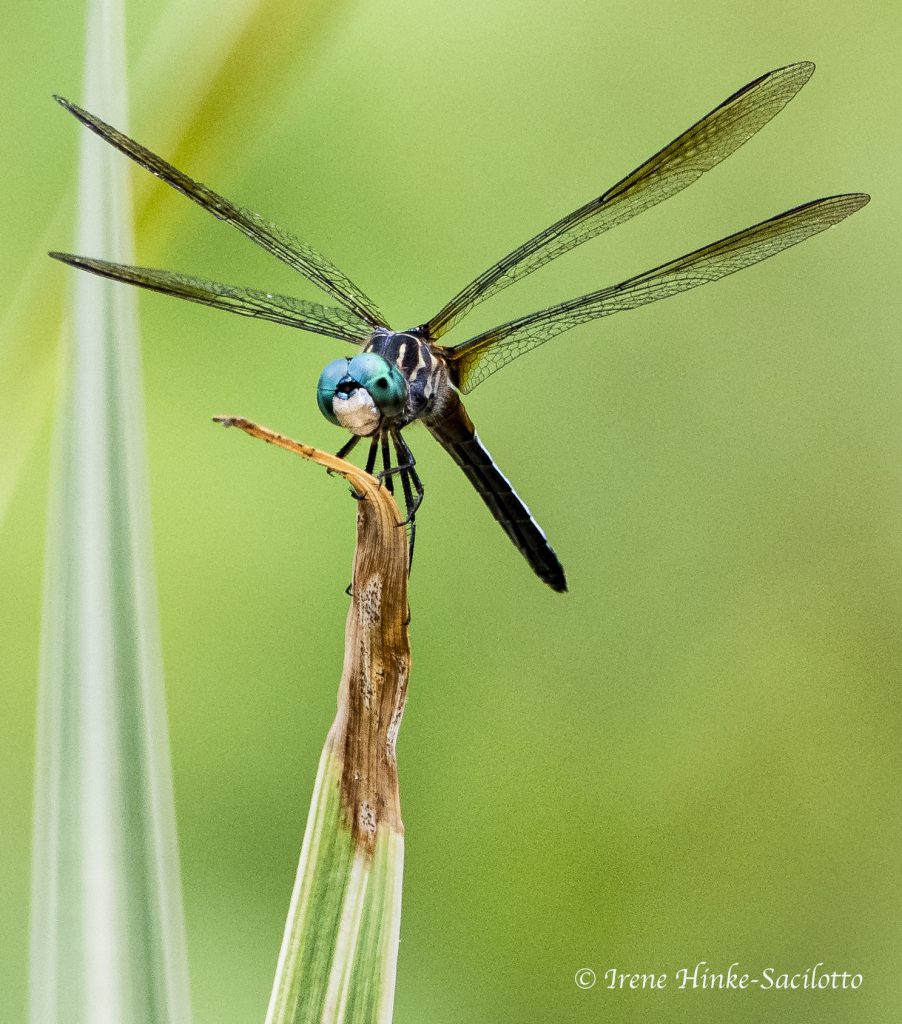
Dragonfly at pond
A couple days when activity at the feeders was low, I switched my attention to smaller subjects, dragonflies and frogs. But I only had my Nikon 200 to 500 mm lens with me instead of my 200 mm macro lens designed for close focusing. When I moved forward towards the subject to increase magnification to what I desired, the autofocus could not lock on it. Remembering a similar situation in the past, I switched to manual focus and discovered I could get closer to the subject and still keep it in focus. For the dragonfly, I had to avoid my shadow falling on it. I took advantage of the fact that if it flew away, it typically returned to the same spot. For the frog photos, I had to be careful to stay low and move slowly. The biggest problem was finding a camera angle where the background was satisfactory.

Gray squirrel peaking around tree trunk.

by Osprey Photo Workshops & Tours | Mar 23, 2020 | Bird behavior, Bird photography, Blue Heron Reclamation Wetlands, Florida, Florida's Atlantic Coast, Nature Photography, Orlando Wetlands, Photo Workshops, Waste Water Reclamation, Wetlands, Wildlife, Wildlife Photography

Florida Sandhill Cranes at Orlando Wetlands
This is Part 1 of a report on the photography along Florida’s East Coast.
The last two weeks of February I flew to the East Coast of Florida to scout for a future photo workshop in March of 2021 or 2022. In the past, I have conducted several workshops in Florida but on the west coast and in the Florida Everglades. This time, I spent 12 days visiting 18 locations along the east coast from St. Augustine to Boca Raton. Sites included wildlife refuges, state parks, zoos, gardens, and wastewater reclamation wetlands. I spent the majority of time at locations where wildlife was abundant and accessible. At other sites, I limited my visit to just enough time to evaluate the area for inclusion in a workshop.
Because of my busy lecture schedule, my visit was limited to late February. Even though it is a month earlier than I plan to offer a workshop, wintering birds were present and nesting was beginning. Breeding birds were carrying sticks, constructing nests, fighting over territory, mating, and displaying. Many wading birds displayed nuptial plumes and the color changes that come with breeding. In a few nests, chicks were present. In late March and early April, heron rookeries are much more active with screeching, hungry chicks and parents busy feeding in order to care for their young.

Sandhill Crane Feeding in field. Orlando Wetlands.

Snowy egret photographed at Orlando Wetlands
Two sites covered by this newsletter are Orlando Wetlands and Blue Heron Water Reclamation Facility and Wetland Area. These are natural and man-made wetlands fed by reclaimed wastewater, creating an environment beneficial to wildlife. Both are within a short drive from Titusville. Florida has a number of these sites with some open to visitation by birders and photographers and others are closed to the public. Some encourage visitation with boardwalks for easy access and viewing of wildlife. Several have bird rookeries within their boundaries.

Limpkin with snail at Orlando Wetlands.
What is reclaimed waste water? It is raw wastewater that has passed through a sewage treatment plant to remove solids, toxic contaminants, and some nutrients. To kill pathogens, the waste is treated with chorine which dissipates before entering the wetlands. This “reclaimed,” non-potable water is sometimes discharged into waterways or dedicated to uses like watering lawns and other purposes, but not as drinking water. However, in some cases when discharged to waterways, the nutrient loading may be high enough to create choking algal blooms which can lower oxygen levels as the algae dies and is decomposed by bacteria. Low dissolved oxygen in waterways can produce “dead zones” where aquatic animals cannot live. On the other hand, when discharged into man-made or natural wetlands, the marsh plants take up the phosphorous and nitrogen and flourish, creating environments suitable for wildlife. For sites using wetland treatment of waste, they are proactively managed and the water tested. Their condition is monitored to benefit flora, fauna, and biochemical processes. In simple terms, at both Orlando and Blue Heron Wetlands, sections of natural or man-made marsh populated with native aquatic plants are impounded and surrounded by dikes with provisions for adjusting the water level as needed. Wetland plants support large populations of tiny aquatic organisms that form the basis of a food chain that supports higher organisms. This rich supply of food acts as a magnet attracting wildlife. In addition, wetlands provide shelter and nesting habitat for birds and serve as a nursery for aquatic organisms.
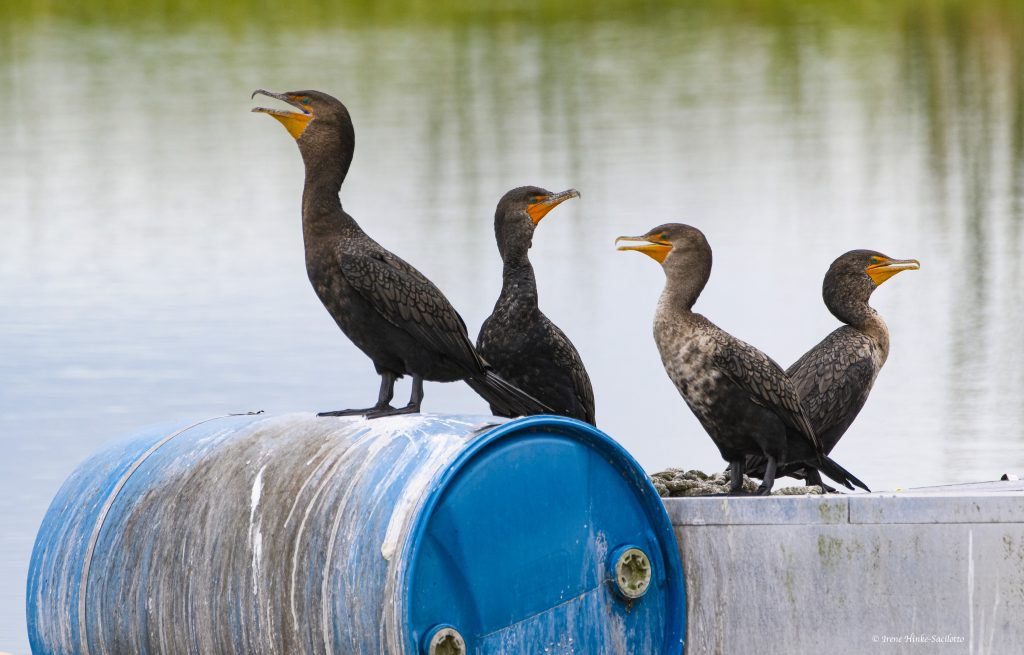
Double-crested Cormorant at Blue Heron Wetlands Facility
In the case of Orlando Wetlands, you can walk along the extensive series of dike roads. At certain times, you can take a tram tour of the facility. In the case of Blue Heron Water Reclamation Wetland Area, you must sign-in & out at their administrative office on site. When I was there, you could drive selected dike roads that provided great opportunities for photography with animals at close range and use to human presence. However, for all locations that I mention in this and the following newsletter, you must check current conditions and regulations.
A number of images in this newsletter are labeled with the location where they were taken. I first visited Orlando Wetlands about a half hour from Titusville. I walked along the dike roads expecting wildlife to be far away and intolerant of my presences. I was pleasantly surprised that many animals just ignored me and went about their normal activities. Alligators, limpkins, ibis, egrets, gallinules, and sandhill cranes were within easy camera range for photography. After conducting several December photo workshops at Bosque del Apache National Wildlife Refuge where thousands of sandhill cranes spend their time from mid-November to mid-February, I was surprised to see several cranes feeding in the first field I encountered. These Florida Sandhill Cranes are resident birds that nest in Florida and don’t migrate. They are omnivorous eating seeds, insects, frogs, mice and other organisms abundant in the marsh. Near Viera Wetlands, I actually saw a crane feeding in someone’s front lawn in the middle of a development. Later I discovered that they can be found on golf courses, parks, and in other public places.

Wood Stork sitting on branch at Orlando Wetland.
To visit Blue Heron Wetlands on weekends, you must make prior arrangements. In general many of the locations I visited were closed on certain days of the week. Those providing early entry for photographers who have purchased photo passes, such as St. Augustine’s Alligator Farm and Gator World’s rookery near Orlando, limit this privilege to certain days of the week or particular months, unfortunate for me February was not included. It is critical to check each location before visiting for rules, open dates, and conditions. For example, a favorite of many photographers, Green Cay Wetlands was closed to visitation due to renovations starting in November 2019. I had visited it several years ago and was impressed with its long boardwalk and large population of nesting birds.

Great Blue Heron at Blue Heron Reclamation Wetlands exposing underside of wings.
In following newsletters, I will cover Merritt Island National Wildlife Refuge and Cape Canaveral National Seashore plus several other areas along Florida’s east coast. The pelican/spoonbill photo at the opening of this newsletter was shot on Merritt Island one morning during my recent visit.

Great Blue Heron resting at Blue Heron Reclamation Facility.

Great Blue Heron at Blue Heron Reclamation Facility.

Red-shouldered Hawk perched in tree on Blue Heron Reclamation Wetland.
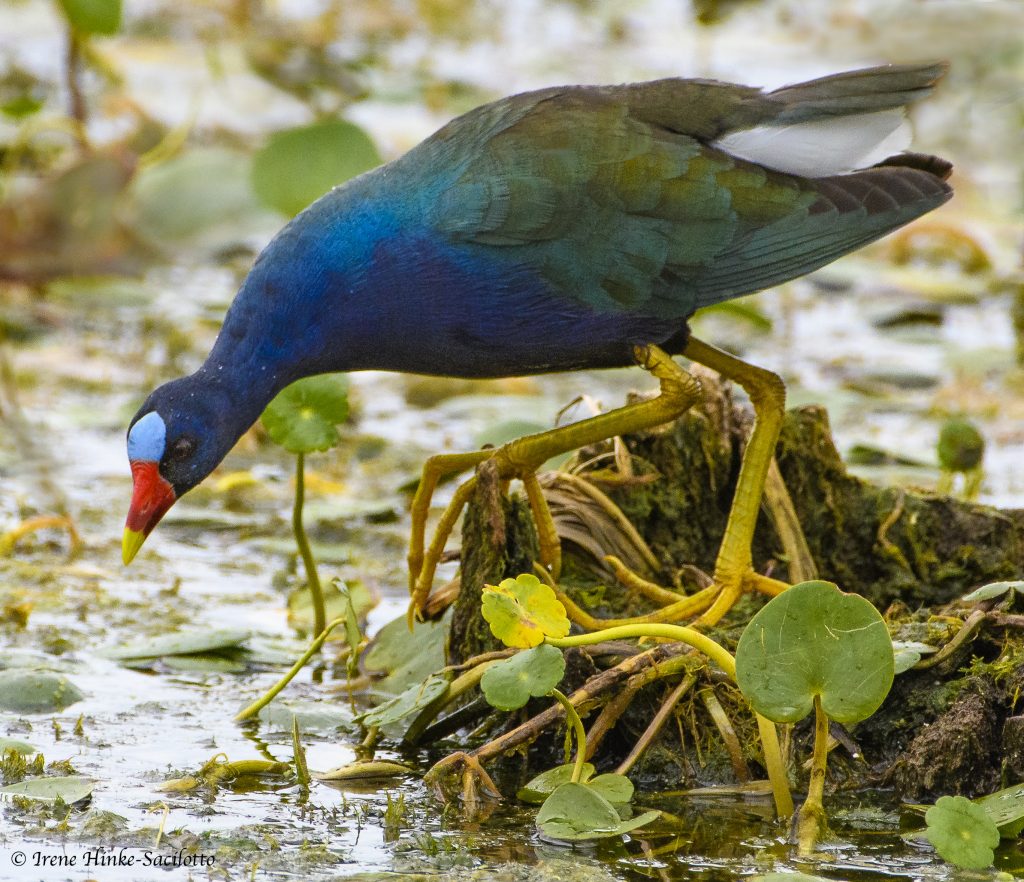
Purple Gallinule Feeding ay Blue Heron Reclamation Wetlands.
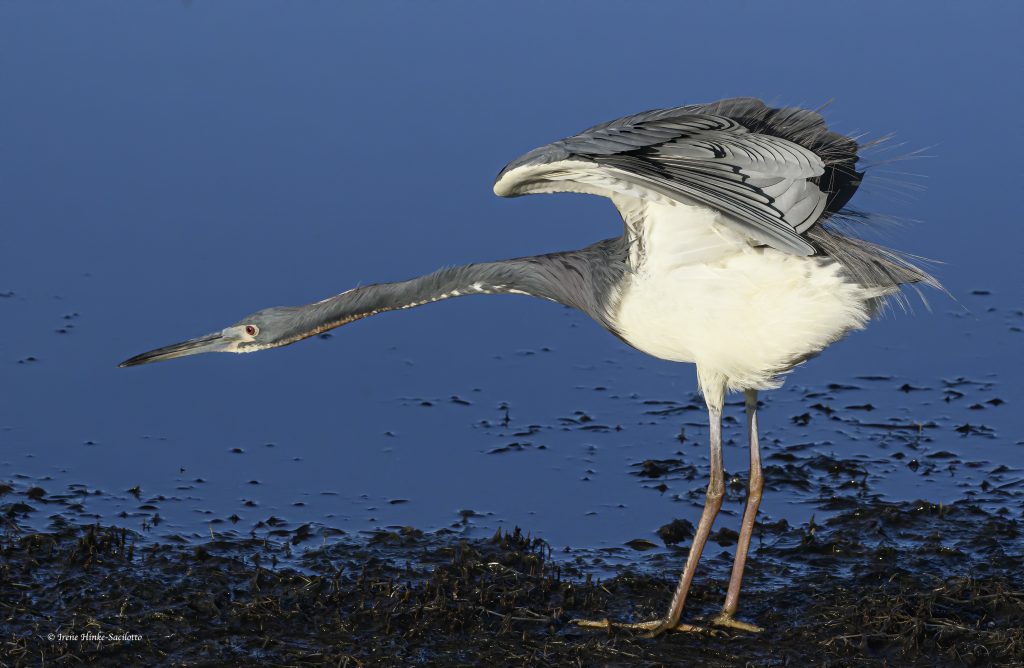
Tricolor Heron stretching on Merritt Island NWR Subject of next blog.

White Pelicans and Spoonbills at Merritt Island NWR.

by Osprey Photo Workshops & Tours | Oct 27, 2019 | Mc Neil River State Game Sanctuary, Nature, Nature Photography, Uncategorized, Wetlands, Wildlife, Wildlife Photography
Passion for Wildlife Photography

Inspiration
Why is wildlife my favorite subject to photograph? To begin, I inherited love of animals from my father. He lived in the Baltimore’s inner city in a row home with 12 siblings, but escaped whenever possible, walking great distances beyond city limit into the woods with his dog by his side. I am grateful for the knowledge he shared and reserving free time to take me for walks in the woods turning over logs looking for salamanders and in treetops for squirrels. He instilled in me an appreciation for nature and love of animals, no matter how common or unusual.
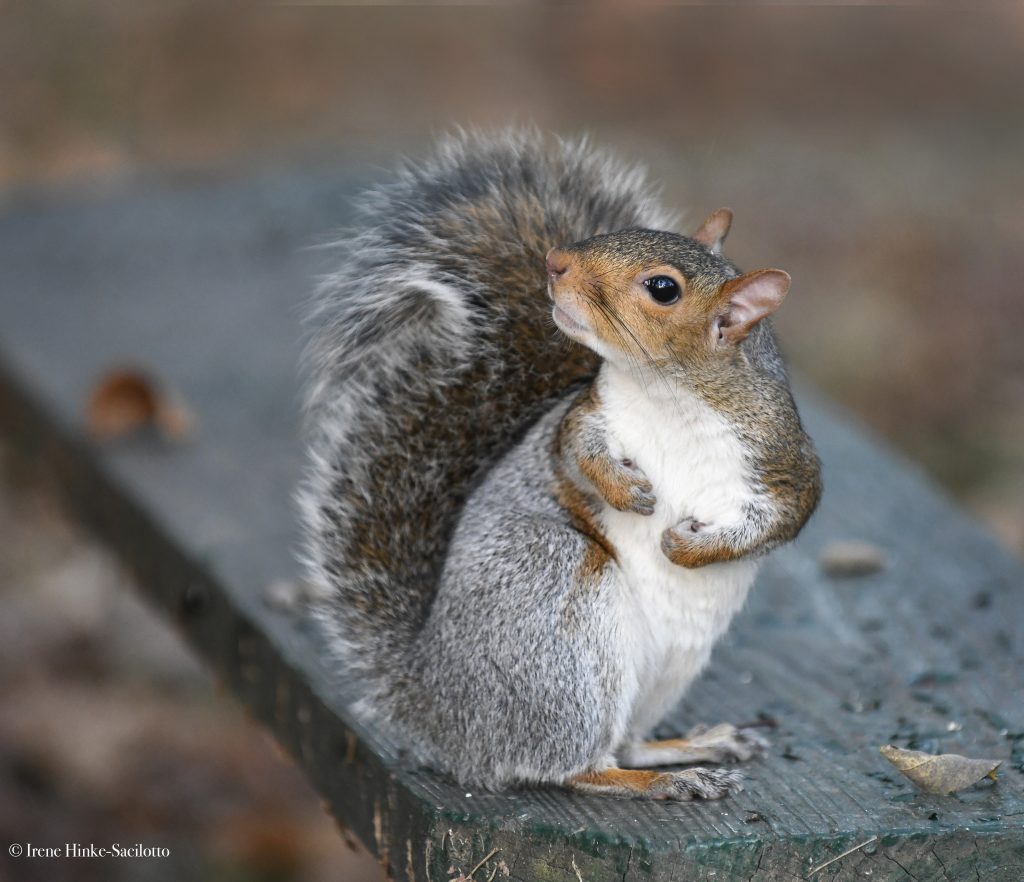
The Eastern Gray Squirrel is commonly found on the east coast of the U.S. They are known for their acrobatic skills. With specialized feet that you can see here, they can hang upside-down on trees trunks, run along the top of a fence, and gain access to the most sophisticate bird feeders.
Engagement & Mindset
I am curious by nature and love the challenges that wildlife photography presents to include locating animals and anticipating behavior. For me, the pursuit of wildlife photography has a calming influence in my life. I call it “Photo Yoga”. When observing animals, my attention is totally focused on the subject. Negative thoughts, worries, and concerns disappear. Immersed in moment, I often instinctively sense what is going to happen next as my subconscious recalls past encounters and visual cues. Even if I never take a shot, each encounter provides me with a mental database that helps me take better images in the future and with stories to share. The observations are often interjected in my presentations for camera clubs and entertain friends. For some photographers, post processing is the favorite part of rendering an image. For me, my greatest joy is capturing images in the field.
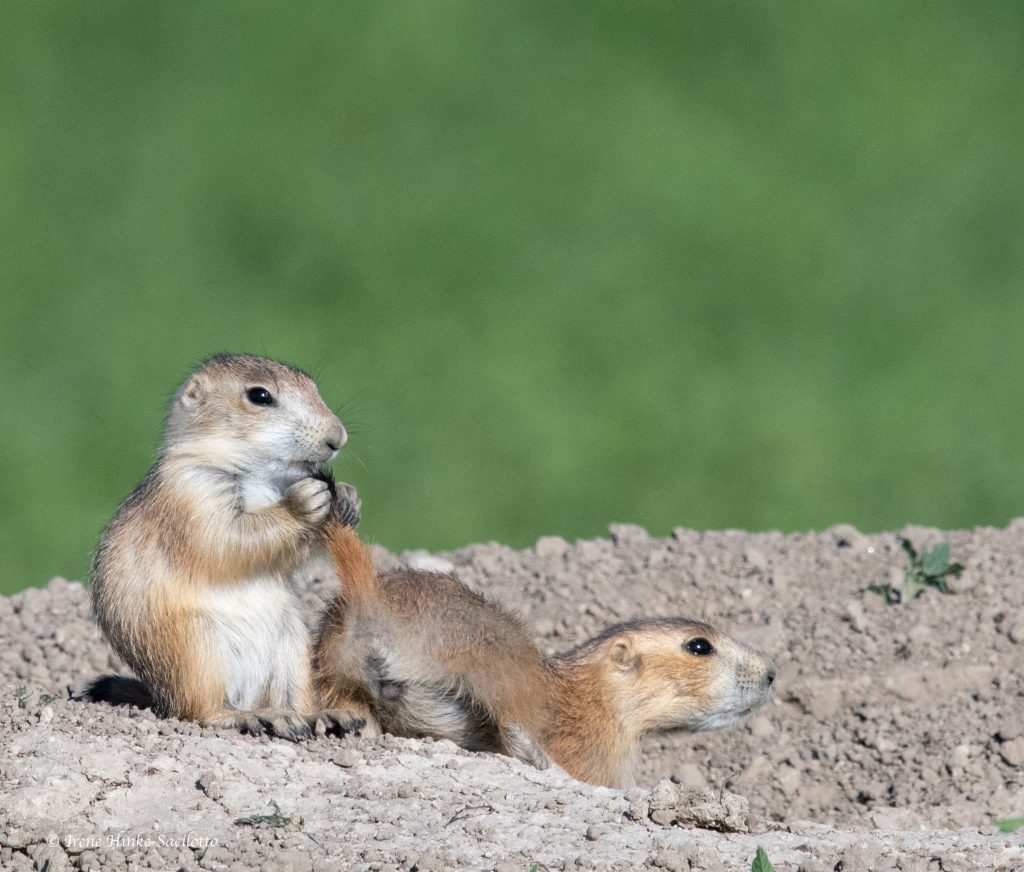
Humor is infectious. I had to laugh when watching this young Black-tailed Prairie Dog playing with the tail of its sibling.
Patience & Perseverance
Patience and perseverance are critical for capturing great images of wildlife behavior. Maybe nothing is happening at the moment. But if you wait, conditions may change. Stay focused but be open to other possible images, different than those you originally had in mind.

This wallaby mom and her joey hung out near my room at O’Reily’s Guest House in Australia. I looked for the pair each day when I walked passed the area. One day, both were in the open and allowed me to capture this and other images.

I spent a long time with this pair of wallabies and took a number of photos of them. This one shows the size of the joey. I suspect junior may shortly be too large to be fit in mom’s pouch.
Knowledge, the Key to Success
The more you know about your subject, the better your photography. Careful observation of animal behavior and research are crucial. Now web searches make gathering information much easier than years ago. Talking to researchers, hunters, fellow photographers, and birders can be quite helpful understanding what you are observing and making it easier to anticipate action.
I saw this Great Egret beginning to stretch after sitting on this branch for a long time. It extended its wing and then stretched its leg. I was lucky to capture this image at the exact moment that the bird’s leg was extended with the wing behind.
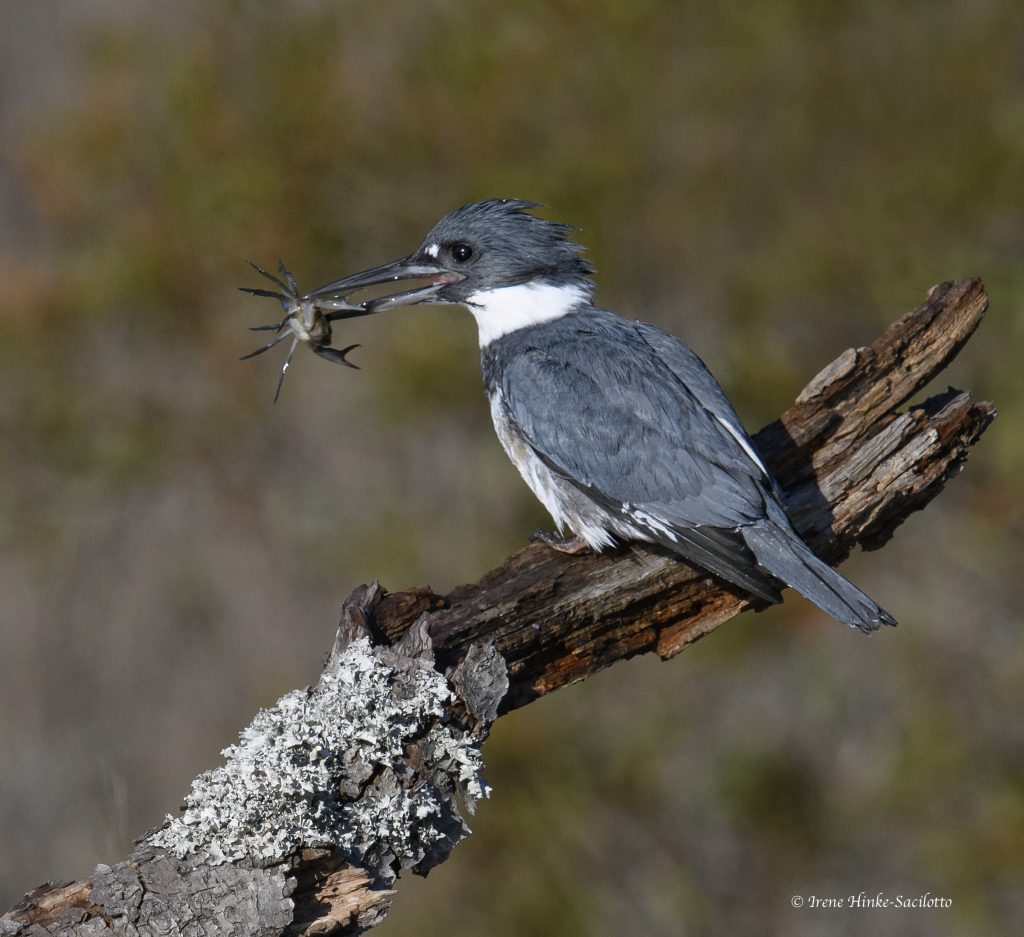
After this Belted Kingfisher caught a crab, it shifted the position of the crab in its bill a number of times trying to eat it. By taking a series of photos in rapid succession, captured this shot at the exact moment that the crab’s claw showed against the background.
Relax and Let your Imagination Soar
Give up preconceptions or labels. Keep an open mind with child-like curiosity and enthusiasm. Be flexible and experiment. Move and change your camera angle. I might lie on my back for an interesting point of view or shoot while lying on my belly. Zoom out for wider views of the surrounding or increase magnification to capture detail. Sometimes I give myself assignments designed to stretch my imagination. I go into the field with a single lens or shoot only with slow shutter speeds.

Ribbon Snake photographed while lying on my belly for a unique point of view.
Identify the Attraction
When photographing, it is important to identify what initially attracted you to the subject. Is it rim-light, texture, patterns, repeating elements, reflections, detail, surprising behavior, unique appearance, etc.? Once you realize what attracted you, then select the lens, approach, and lighting that best captures that feature. Look for shots that tell a story and unique behavior.
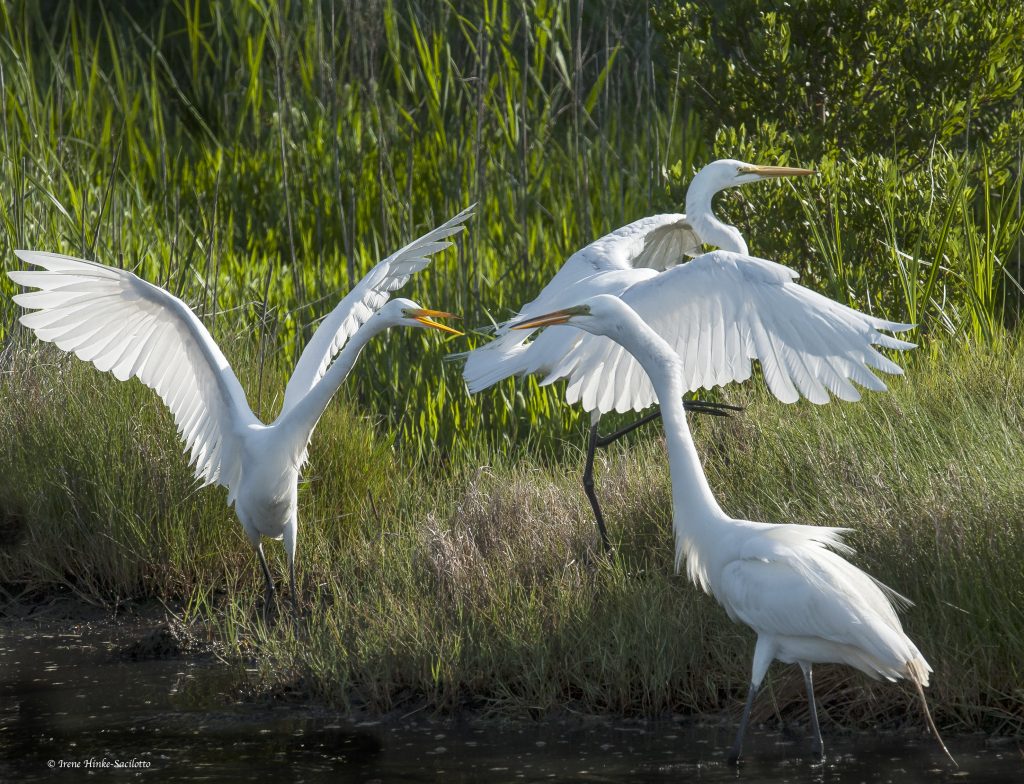
This image shows Great Egret fighting over something. In this case, the squabble was over a pool of water filled with small fish. Apparently, the third bird wanted no part of the disagreement.

Sanderlings are small shorebirds that feed along the shoreline. When waves retreat, the birds follow and feed on mole crabs and other organisms as wet sand is exposed. With incoming surf, they run ahead of it to avoid being swamped.
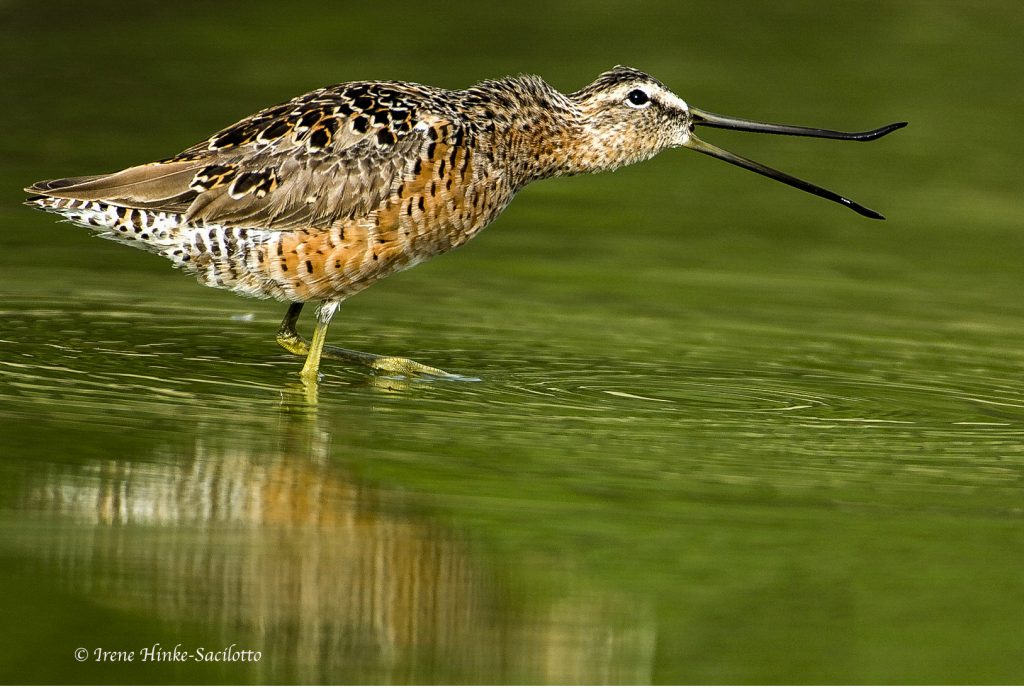
This photo of this Long-billed Dowitcher yawning, shows that the bill is not rigid. The tip with tactile receptors can be manipulated as it feeds making it possible for it to locate prey by touch.
Refining your Images
In the field, I continuously refine my images. Typically if there is time, I take a series of photographs attempting to make each one better than the last. I examine the composition, carefully scan the edges of the frame, and look for potential flaws and distractions. I also consider alternative points of view so I can take full advantage of each situation. I look for lines, contrast, color, etc. that can lead to the subject and keep the viewer’s eye engaged and within the frame. I may spend hours with one subject or return day after day.
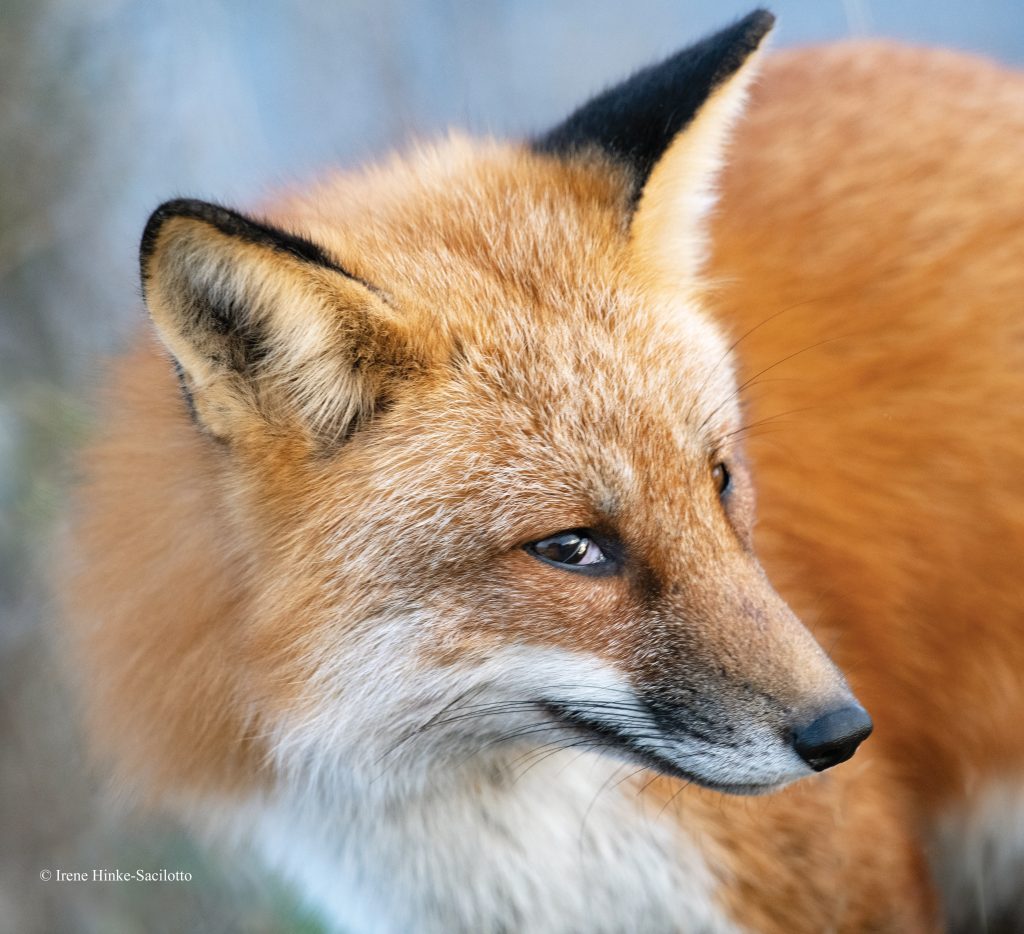
Red Fox image captured with an expression that suggests the saying “sly as a fox”. I took several shots of the fox at the time but this was the only one with this look.
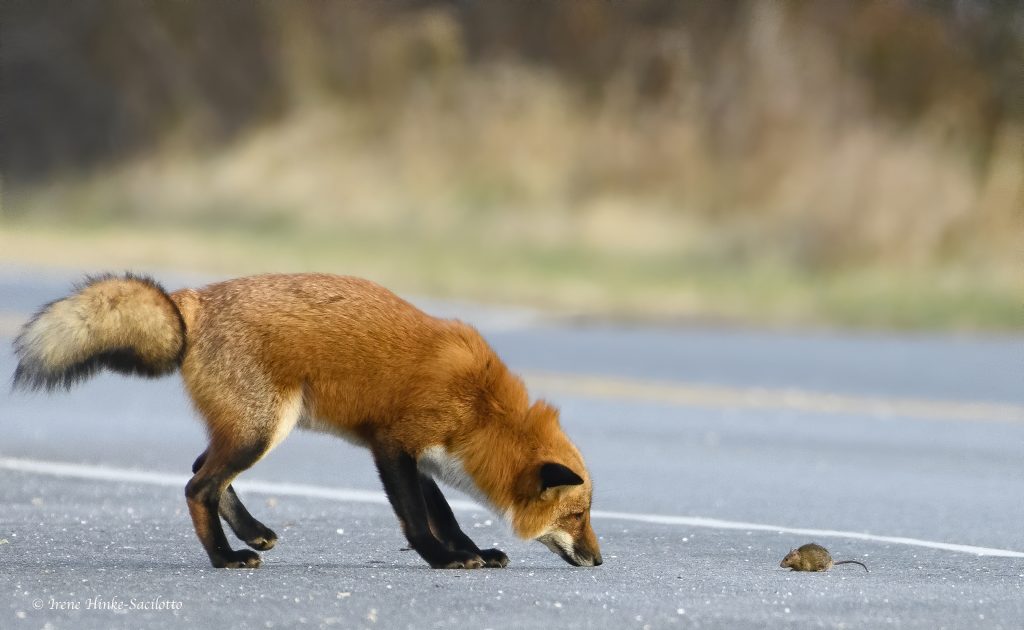
Red Fox standoff with mouse at Chincoteague, NWR. Every day during this trip I looked for fox in same area where I first saw it. Eventually I spotted it toying with a mouse and moved in to take this photo.
Background Control
Sometimes I squint my eyes when looking at a scene to exclude less important details and see what stands out (including lines, forms, etc.) or could present a problem. For example, I use this technique when photographing a subject as a silhouette to be sure its shape does not blend with other unlit portions of the scene and that the animal is recognizable by outline alone.

Silhouette of heron with fish in bill.
For close-up photography, I sometimes shift my camera’s focus off the subject and focus on the background for an instant. This technique allows me to more easily see if strong forms, bright highlights, or other distractions are in the background and may be a problem. Then I refocus on the subject with this information in mind.
The longer the focal length of the lens, the narrower angle of view. So, these telephoto lenses can help you exclude a something distracting in the background. Small shifts in the camera position can dramatically control what appears behind your subject. In some situations where the subject is in sunlight but the background is distracting, I position camera so that a shadowed area falls behind my subject. This approach creates a dramatic image, as is if the animal is lit by a spotlight.

Yellow-Crowned Night Heron after catching soft crab. The bird was in sunlight but the background was in shadow. I made the image a bit more dramatic by darkened the backgound even more during post-processing .
Shooting from a position level with your subject is often desirable, producing less distortion of the image and suggesting a more intimate relationship between you and your wildlife subject. The lower angle can also help isolate the subject if the background is distant and well out of the depth of field.

Black-Tailed Prairie Dog family

Black-Tailed Prairie Dogs nose to nose.
Capturing the Unusual
I love capturing the unique aspects of an animal’s morphology and behavior. I look for the unexpected, humor, or the emotion evoked by the scene. Every situation is unique, for the behavior, environment, and lighting is never the same. Don’t pass up on an opportunity expecting it to be there tomorrow. It won’t!
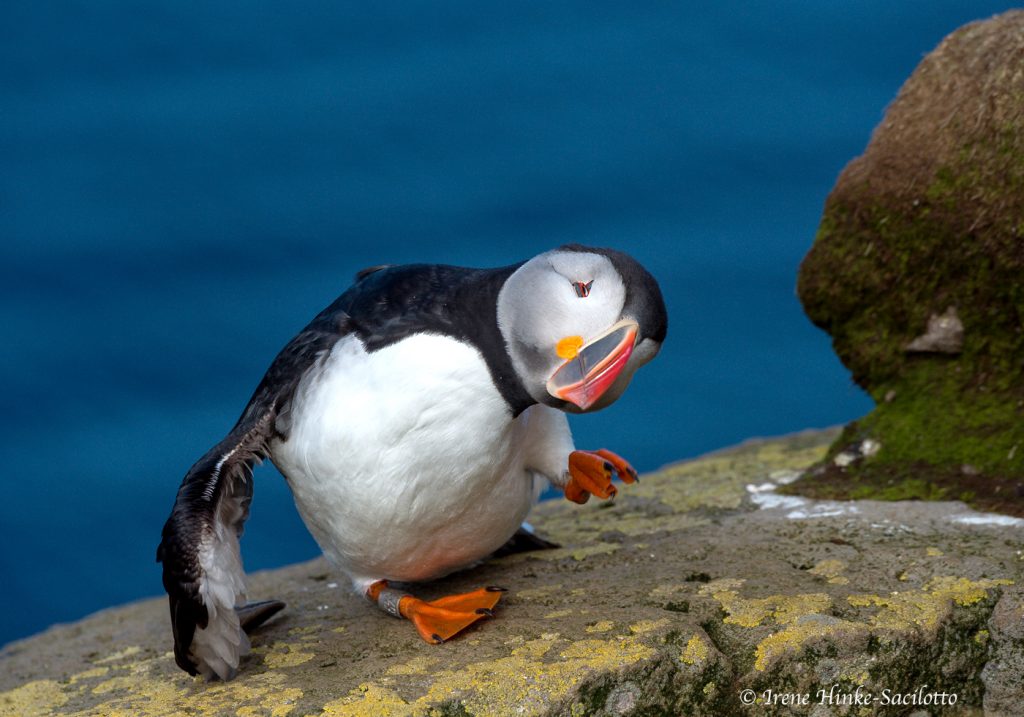
Unique photo of Atlantic Puffin using wing for balance while scratching.
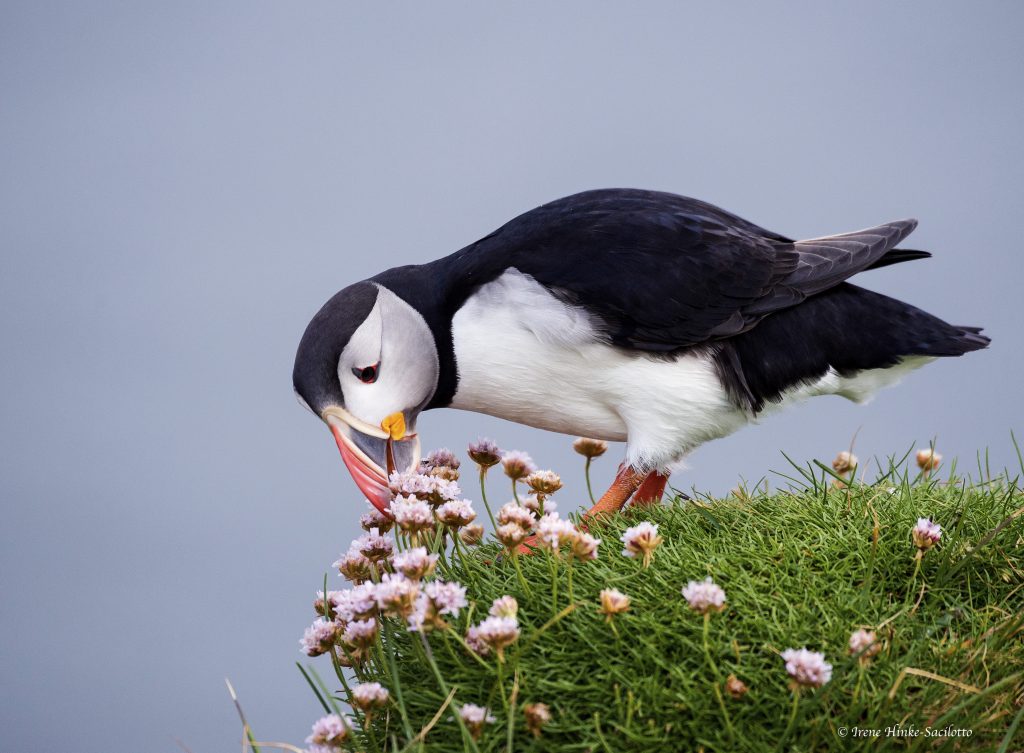
Atlantic Puffin eating flowers. This was so unexpected, that I took a number of photos at the time but only one best showed what the puffin was doing. The distant background and relatively shallow depth of field helped make the bird bird and flowers standout.
Imaginary Gallery
To judge the impact of a photograph, I sometimes imagine it hanging on the wall in a gallery. I examine the photo as if seeing it for the first time. Then I ask myself, have I conveyed the thoughts and feelings I experienced while taking the photo? Is the composition static – perhaps with the subject centered or with the horizon in the middle of the frame? Is the viewers eye drawn into the scene? Does it convey a story?

This is a humorous shot of a young Brown Bear struggling to hold onto a slippery salmon at McNeil State Game Sanctuary in Alaska. I love the story.
I always am learning something new from magazine articles, youtube, experiences in the field, and from other photographers. I keep my workshops small so I can provide individual attention to each person, no matter their skill level. No one should ever be embarrassed to ask questions. I typically learn something each time I conduct a program. If you have an open mind and see disappointments as opportunities, you will gain from your experiences. Everyone has his own unique vision. This becomes very obvious during my workshop image reviews. Even though the photographers are at the same location at the same time, the resulting mages are normally quite different.

by Osprey Photo Workshops & Tours | Mar 13, 2019 | Alaska, Bald Eagle, Bristol Bay, Brown Bears, Environmental Impact, Mc Neil River State Game Sanctuary, Nature, Wetlands, Wildlife
Pebble Mine and Its Negative Environmental Impact
The following expresses my feelings and concerns about construction and operation of the Pebble Mine in Southeast Alaska and it negative impact on the environment and Bristol Bay ecosystem, spawning sockeye salmon, and the bears of Southeast Alaska.

Bald Eagle in Homer.
The construction of one of the world’s largest open-pit mines will require the building of significant amounts of supporting infrastructure, including roads, a power plant, pipelines, and a port, and the resulting development would have destructive environmental impacts for hundreds of square miles. The disturbance of this pristine area including Mc Neil River State Game Sanctuary and Katmai National Park where coastal brown bears gather each year to feed on salmon is distressing. The application submitted to the Army Corps of Engineers includes a deep-water port at Amakdedori beach and road that stretches across prime bear habitat from near Kokhanok, AK to the shoreline. This proposed road comes within a mile of the McNeil River State Game Refuge boundary and the port facility is within sight of a world class bear viewing destination.
The activity along the road and associated construction and operation of a deep-water port nearby and mine is bound to have a highly detrimental effect on the bears and other wildlife that live in the area. For years the government has exercised great care to protect the bears and provide safe bear-viewing for the public. This includes minimizing negative interactions between the bears and humans by enforcing rules to avoid harmful encounters. Activities around the mine and port will certainly undo these efforts.
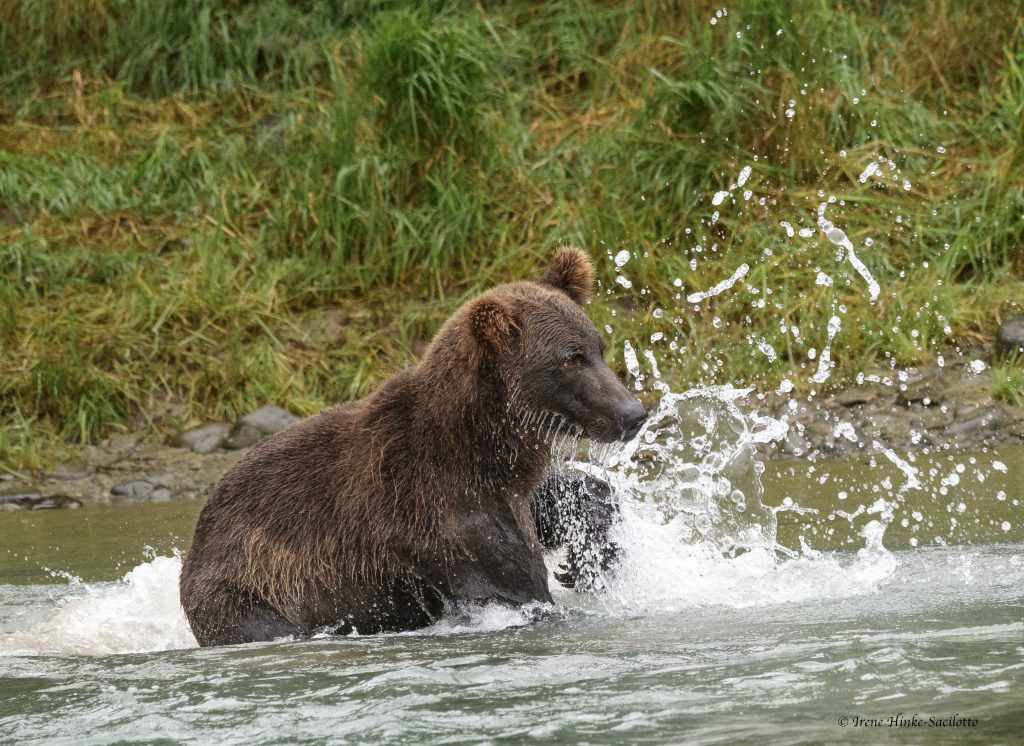
Brown bear chasing salmon.
People from all over the world are attracted to Alaska for the possibility of seeing bears and other wildlife roaming free. They spend millions of dollars in Alaska for the opportunity and contribute billions to the economy of Alaska – food, transportation, lodging, tour guides, park fees, etc.
Regarding Mc Neil River, there is no place like it anywhere in the world. I am now 70 and last year I had the privilege of visiting Mc Neil River, after a number of years trying to win the state lottery for the privilege. It was one of the most incredible experiences I have had in my life. I am a professional wildlife photographer and nature photo tour leader. I have been to Africa, Argentina, Iceland, Chile, Newfoundland, the Falkland Islands, Northwest Territory, Churchill Manitoba, Nome, Australia, and New Zealand, so I have been to many premiere natural areas around the world. But I never experienced a thrill like that of sitting quietly photographing and watching the bears feeding on salmon at the lower falls at Mc Neil, feeling unthreatened with some bears walked by only 12 feet away.

Brown Bear Standing in grasses near lower falls of Mc Neil River.
I was horrified when I found out that the Pebble Mine project may be approved. The largest sockeye salmon run in the world will be disrupted along with the fishery industry in Southeast Alaska. Equally important, bears and other wildlife (bald eagles, killer whales, other marine animals, etc.) will be adversely effected since they depend on the salmon for survival. Removal of groundwater in order to operate the mine will dry up streams, lakes, and wetlands necessary for salmon eggs, young salmon, and their food source to survive. No amount of recycling the water supply after waste water cleanup will return the water and waterways to their original state. The mine with its associated structures is located near a fault, in an area where earth quakes and severe storms with heavy rainfall are possible. Not only will the blasting involved in the mining process disturb wildlife but I question whether it could actually trigger earthquakes. The acid waste from extracting copper and gold from pulverized ore contains cyanide, toxic metals such as lead, selenium, cadmium, and arsenic, and other contaminants can potentially leach into nearby waterways and lakes. Efforts to permanently contain this poisonous waste are destined to fail.
It is not worth damaging Alaska’s natural resources including the fragile Bristol Bay ecosystem and wildlife populations just to benefit developers and foreign investors. Any perceived economic benefit will be offset by the cost of restoration if there is a mishap during the construction or operation of the mine, deep water port, and any associated activities. Remember the Exxon Valdes oil spill, a tragedy thought to be unimaginable. The damage to the environment was catastrophic and the cost of clean-up was in the billions of dollars. The benefit from the construction of the Pebble Mine is not worth the threat to human population nearby and the incredible ecosystem where salmon spawn and bears roam free. This pristine region of Southeast Alaska is unique in the world. In addition, Issuing a permit for the construction of the Pebble Mine will open up other areas in the Bristol Bay region and southeast Alaska to mining which will result in farther degradation of the environment and more threats to wildlife.
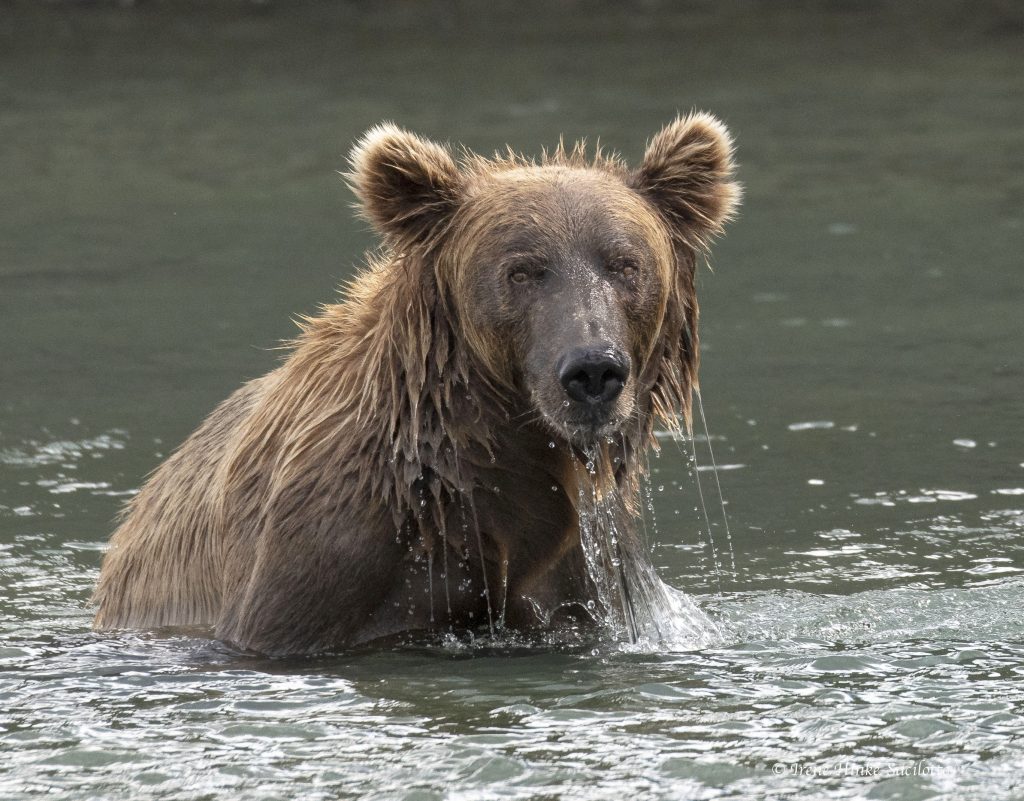
Coastal Brown Bear feeding in the waters at the lower falls of Mc Neil River.
What kind of world to you want to leave for your grandchildren?
What Makes America Great are places like Mc Neil River State Game Sanctuary where in July as many as 80 brown bears gather to feed on salmon, where millions of sockeye salmon spawn, and where wildlife thrives on the land and in the waters of Bristol Bay.
I believe that the Pebble Mine Draft Environmental Impact Statement should be resubmitted and replaced with one that is more comprehensive and backed by data that can validated. This project is huge with many ramifications and the potential of having far-reaching negative on the environmental and the delicate ecosystem of Bristol Bay. That which it will destroy, cannot be replaced.
See my previous blog on Mc Neil River State Game Sanctuary and Coastal Brown Bears.
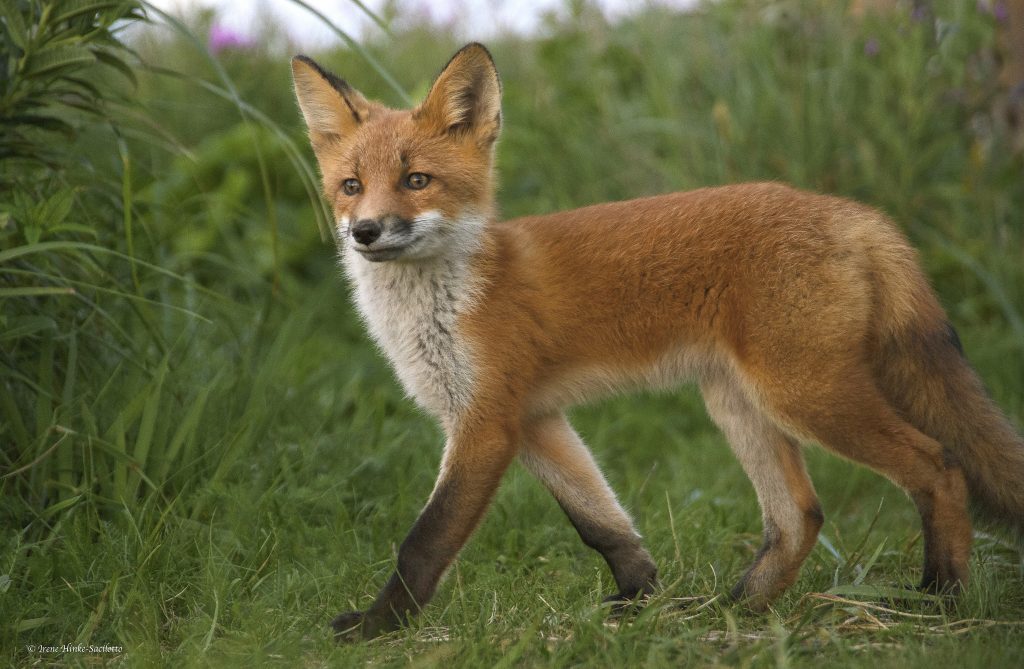
Young Red Fox in South East Alaska.
***********
For more info and links on the Pebble Mine and where you can comment to the Corp of Engineers regarding the project.
Orvis.com/nopebblemine
Regarding the Army Corp of Engineers approval of the Draft Environmental Impact Statement on the Pebble Mine you can go to their website. https://www.pebbleprojecteis.com/ A quote from their web page reads as follows: “The public comment period will run from March 1, 2019 through May 30, 2019. You can submit comments through testimony at public meetings, email to drafteis@comments.pebbleprojecteis.com or mail them to:
Program Manager
US Army Corps of Engineers
645 G St.
Suite 100-921
Anchorage, AK 99501
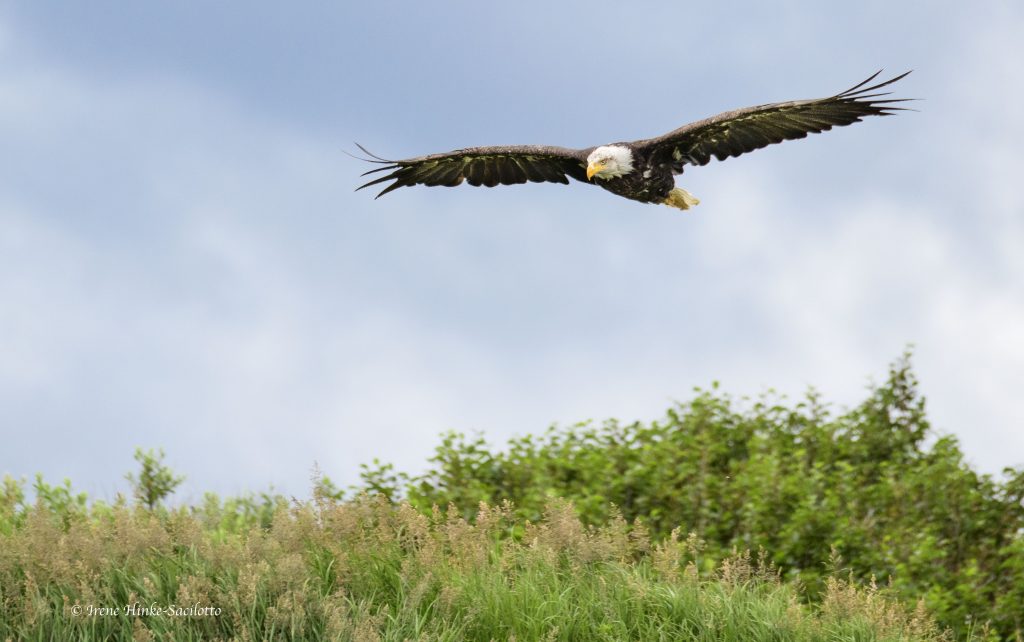
Bald Eagle flying over cliff at Mc Neil River State Game Sanctuary.
















 Atlantic Shore
Atlantic Shore

 x
x










































































